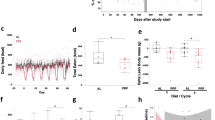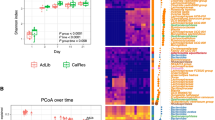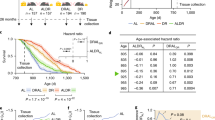Abstract
Calorie restriction (CR) without malnutrition increases life span and health span in multiple model organisms. In non-human and human primates, CR causes changes that protect against several age-related pathologies, reduces inflammation, and preserves or improves cell-mediated immunity. However, CR has also been shown to exhibit adverse effects on certain organs and systems, including the immune system, and to impact genetically different organisms of the same species differentially. Alternately, short periods of fasting followed by refeeding may result in the proliferation of bone marrow stem cells, suggesting a potential rejuvenation effect that could impact the hematopoietic compartment. However, the global consequences of CR followed by refeeding on the immune system have not been carefully investigated. Here, we show that individuals practicing long-term CR with adequate nutrition have markedly lower circulating levels of total leukocytes, neutrophils, lymphocytes, and monocytes. In 10-month-old mice, short-term CR lowered lymphocyte cellularity in multiple lymphoid tissues, but not in bone marrow, which appears to be a site of influx, or a “safe haven” for B, NK, and T cells during CR. Cellular loss and redistribution was reversed within the first week of refeeding. Based on BrdU incorporation and Ki67 expression assays, repopulating T cells exhibited high proliferation in the refeeding group following CR. Finally, we demonstrated that the thymus was not essential for T cell repopulation following refeeding. These findings are of potential relevance to strategies to rejuvenate the immune system in mammals and warrant further investigation.







Similar content being viewed by others
References
Becklund BR, Purton JF, Ramsey C, Favre S, Vogt TK, Martin CE, Spasova DS, Sarkisyan G, LeRoy E, Tan JT, Wahlus H, Bondi-Boyd B, Luther SA, Surh CD (2016) The aged lymphoid tissue environment fails to support naïve T cell homeostasis. Sci Rep 6:30842. https://doi.org/10.1038/srep30842
Beura LK, Hamilton SE, Bi K, Schenkel JM, Odumade OA, Casey KA, Thompson EA, Fraser KA, Rosato PC, Filali-Mouhim A, Sekaly RP, Jenkins MK, Vezys V, Haining WN, Jameson SC, Masopust D (2016) Normalizing the environment recapitulates adult human immune traits in laboratory mice. Nature 532:512–516. https://doi.org/10.1038/nature17655
Brandhorst S, Choi IY, Wei M, Cheng CW, Sedrakyan S, Navarrete G, Dubeau L, Yap LP, Park R, Vinciguerra M, di Biase S, Mirzaei H, Mirisola MG, Childress P, Ji L, Groshen S, Penna F, Odetti P, Perin L, Conti PS, Ikeno Y, Kennedy BK, Cohen P, Morgan TE, Dorff TB, Longo VD (2015) A periodic diet that mimics fasting promotes multi-system regeneration, enhanced cognitive performance, and healthspan. Cell Metab 22:86–99. https://doi.org/10.1016/j.cmet.2015.05.012
Cheng CW, Adams GB, Perin L, Wei M, Zhou X, Lam BS, da Sacco S, Mirisola M, Quinn DI, Dorff TB, Kopchick JJ, Longo VD (2014) Prolonged fasting reduces IGF-1/PKA to promote hematopoietic-stem-cell-based regeneration and reverse immunosuppression. Cell Stem Cell 14:810–823. https://doi.org/10.1016/j.stem.2014.04.014
Čičin-Šain L, Messaoudi I, Park B, Currier N, Planer S, Fischer M, Tackitt S, Nikolich-Zugich D, Legasse A, Axthelm MK, Picker LJ, Mori M, Nikolich-Žugich J (2007) Dramatic increase in naive T cell turnover is linked to loss of naive T cells from old primates. Proc Natl Acad Sci 104:19960–19965. https://doi.org/10.1073/pnas.0705905104
Colman RJ, Anderson RM, Johnson SC, et al (2009) recommendations. Ongoing full genome sequencing will monitor for the possibility of future reassortment events (39). Science (80) 201–204
Colman RJ, Beasley TM, Kemnitz JW, Johnson SC, Weindruch R, Anderson RM (2014) Caloric restriction reduces age-related and all-cause mortality in rhesus monkeys. Nat Commun 5:3557. https://doi.org/10.1038/ncomms4557
Ehninger D, Neff F, Xie K (2014) Longevity, aging and rapamycin. Cell Mol Life Sci 71:4325–4346. https://doi.org/10.1007/s00018-014-1677-1
Ferrando-Martínez S, Ruiz-Mateos E, Hernández A, Gutiérrez E, Rodríguez-Méndez MM, Ordoñez A, Leal M (2011) Age-related deregulation of naive T cell homeostasis in elderly humans. Age (Omaha) 33:197–207. https://doi.org/10.1007/s11357-010-9170-8
Ferrando-Martínez S, Romero-Sánchez MC, Solana R, Delgado J, de la Rosa R, Muñoz-Fernández MÁ, Ruiz-Mateos E, Leal M (2013) Thymic function failure and C-reactive protein levels are independent predictors of all-cause mortality in healthy elderly humans. Age (Omaha) 35:251–259. https://doi.org/10.1007/s11357-011-9341-2
Fontana L, Partridge L, Longo VD (2010) Extending healthy life span—from yeast to humans. Science 328:321–326. https://doi.org/10.1126/science.1172539
Fryar CD, Carroll MD, Ogden CL (2012) Prevalence of overweight, obesity, and extreme obesity among adults: United States, trends 1960–1962 through 2009–2010
Gardner EM (2005) Caloric restriction decreases survival of aged mice in response to primary influenza infection. J Gerontol A Biol Sci Med Sci 60:688–694
Godfrey DI, Kennedy J, Suda T, Zlotnik A (1993) A developmental pathway involving four phenotypically and functionally distinct subsets of CD3-CD4-CD8-triple-negative adult mouse thymocytes defined by CD44 and CD25 expression. J Immunol 150:4244–4252
Goldberg EL, Romero-Aleshire MJ, Renkema KR, Ventevogel MS, Chew WM, Uhrlaub JL, Smithey MJ, Limesand KH, Sempowski GD, Brooks HL, Nikolich-Žugich J (2015) Lifespan-extending caloric restriction or mTOR inhibition impair adaptive immunity of old mice by distinct mechanisms. Aging Cell 14:130–138. https://doi.org/10.1111/acel.12280
Hambly C, Rauw W, Speakman JR (2015) Mice that gorged during dietary restriction increased foraging related behaviors and differed in their macronutrient preference when released from restriction. doi: https://doi.org/10.7717/peerj.1091
Heilbronn LK, Ravussin E (2003) Calorie restriction and aging: review of the literature and implications for studies in humans. Am J Clin Nutr 78:361–369
Johnson SC, Rabinovitch PS, Kaeberlein M (2013) mTOR is a key modulator of ageing and age-related disease. Nature 493:338–345. https://doi.org/10.1038/nature11861
Koup RA, Douek DC, McFarland RD et al (1998) Changes in thymic function with age and during the treatment of HIV infection. Nature 396:690–695. https://doi.org/10.1038/25374
Kristan DM (2007) Chronic calorie restriction increases susceptibility of laboratory mice (Mus musculus) to a primary intestinal parasite infection. Aging Cell 6:817–825. https://doi.org/10.1111/j.1474-9726.2007.00345.x
Liao C-Y, Rikke BA, Johnson TE, Diaz V, Nelson JF (2010) Genetic variation in the murine lifespan response to dietary restriction: from life extension to life shortening. Aging Cell 9:92–95. https://doi.org/10.1111/j.1474-9726.2009.00533.x
Mahoney LB, Denny CA, Seyfried TN (2006) Caloric restriction in C57BL/6J mice mimics therapeutic fasting in humans. Lipids Health Dis 5:13. https://doi.org/10.1186/1476-511X-5-13
Martin-Montalvo A, Mercken EM, Mitchell SJ, Palacios HH, Mote PL, Scheibye-Knudsen M, Gomes AP, Ward TM, Minor RK, Blouin MJ, Schwab M, Pollak M, Zhang Y, Yu Y, Becker KG, Bohr VA, Ingram DK, Sinclair DA, Wolf NS, Spindler SR, Bernier M, de Cabo R (2013) Metformin improves healthspan and lifespan in mice. Nat Commun 4:2192. https://doi.org/10.1038/ncomms3192
Mattison JA, Roth GS, Beasley TM et al (2012) Impact of caloric restriction on health and survival in rhesus monkeys from the NIA study. Nature 489:318–321. https://doi.org/10.1038/nature11432
Messaoudi I, Warner J, Fischer M, Park B, Hill B, Mattison J, Lane MA, Roth GS, Ingram DK, Picker LJ, Douek DC, Mori M, Nikolich-Žugich J (2006) Delay of T cell senescence by caloric restriction in aged long-lived nonhuman primates. Proc Natl Acad Sci 103:19448–19453. https://doi.org/10.1073/pnas.0606661103
Meydani SN, Das SK, Pieper CF, Lewis MR, Klein S, Dixit VD, Gupta AK, Villareal DT, Bhapkar M, Huang M, Fuss PJ, Roberts SB, Holloszy JO, Fontana L (2016) Long-term moderate calorie restriction inhibits inflammation without impairing cell-mediated immunity: a randomized controlled trial in non-obese humans. Aging (Albany NY) 8:1416–1431. https://doi.org/10.18632/aging.100994
Most J, Tosti V, Redman LM, Fontana L (2017) Calorie restriction in humans: an update. Ageing Res Rev 39:36–45. https://doi.org/10.1016/j.arr.2016.08.005
Naylor K, Li G, Vallejo AN, Lee WW, Koetz K, Bryl E, Witkowski J, Fulbright J, Weyand CM, Goronzy JJ (2005) The influence of age on T cell generation and TCR diversity. J Immunol 174:7446–7452. https://doi.org/10.4049/jimmunol.174.11.7446
Nikolich-Žugich J (2014) Aging of the T cell compartment in mice and humans: from no naive expectations to foggy memories. J Immunol 193:2622–2629. https://doi.org/10.4049/jimmunol.1401174
Nikolić-Žugić J (1991) Phenotypic and functional stages in the intrathymic development of αβ T cells. Immunol Today 12:65–70. https://doi.org/10.1016/0167-5699(91)90160-U
Nolz JC, Starbeck-Miller GR, Harty JT (2011) Naive, effector and memory CD8 T-cell trafficking: parallels and distinctions. Immunotherapy 3:1223–1233. https://doi.org/10.2217/imt.11.100
Ortman BJM, Velkoff VA, Hogan H (2014) An aging nation: the older population in the United States Curr Popul Reports 1964:
Parmigiani A, Alcaide ML, Freguja R, Pallikkuth S, Frasca D, Fischl MA, Pahwa S (2013) Impaired antibody response to influenza vaccine in HIV-infected and uninfected aging women is associated with immune activation and inflammation. PLoS One 8:e79816. https://doi.org/10.1371/journal.pone.0079816
Rezzani R, Nardo L, Favero G, Peroni M, Rodella LF (2014) Thymus and aging: morphological, radiological, and functional overview. Age (Omaha) 36:313–351. https://doi.org/10.1007/s11357-013-9564-5
Rudd BD, Venturi V, Li G, Samadder P, Ertelt JM, Way SS, Davenport MP, Nikolich-Žugich J (2011) Nonrandom attrition of the naive CD8+ T-cell pool with aging governed by T-cell receptor: pMHC interactions. Proc Natl Acad Sci U S A 108:13694–13699. https://doi.org/10.1073/pnas.1107594108
Sempowski GD, Gooding ME, Liao HX, le PT, Haynes BF (2002) T cell receptor excision circle assessment of thymopoiesis in aging mice. Mol Immunol 38:841–848
Sun D, Muthukumar AR, Lawrence RA, Fernandes G (2001) Effects of calorie restriction on polymicrobial peritonitis induced by cecum ligation and puncture in young C57BL/6 mice. Clin Diagn Lab Immunol 8:1003–1011. https://doi.org/10.1128/CDLI.8.5.1003-1011.2001
Thompson HL, Smithey MJ, Surh CD, Nikolich-Žugich J (2017) Functional and homeostatic impact of age-related changes in lymph node stroma. Front Immunol 8:706. https://doi.org/10.3389/fimmu.2017.00706
Vescovini R, Fagnoni FF, Telera AR, Bucci L, Pedrazzoni M, Magalini F, Stella A, Pasin F, Medici MC, Calderaro A, Volpi R, Monti D, Franceschi C, Nikolich-Žugich J, Sansoni P (2014) Naïve and memory CD8 T cell pool homeostasis in advanced aging: impact of age and of antigen-specific responses to cytomegalovirus. Age (Dordr) 36:625–640. https://doi.org/10.1007/s11357-013-9594-z
Weindruch R, Sohal RS (1997) Caloric intake and aging. N Engl J Med 337:986–994. https://doi.org/10.1056/NEJM199710023371407
Weindruch R, Lane MA, Ingram DK, Ershler WB, Roth GS (1997) Dietary restriction in rhesus monkeys: lymphopenia and reduced mitogen-induced proliferation in peripheral blood mononuclear cells. Aging (Milano) 9:304–308
Wing EJ, Magee DM, Barczynski LK (1988) Acute starvation in mice reduces the number of T cells and suppresses the development of T-cell-mediated immunity. Immunology 63:677–682
Yang H, Youm Y-H, Dixit VD (2009) Inhibition of thymic adipogenesis by caloric restriction is coupled with reduction in age-related thymic involution. J Immunol 183:3040–3052. https://doi.org/10.4049/jimmunol.0900562
Funding
This study is supported by the grant AG045734 from the USPS (National Institute of Aging, NIH) to J.N-Z and grants from the Bakewell Foundation, the Longer Life Foundation (an RGA/Washington University Partnership), and the National Center for Research Resources (UL1 RR024992) to L.F. This research was also supported in part by the National Institute on Aging-Intramural Research Program; the funding agencies had no role in the analysis or interpretation of the data or in the decision to submit the report for publication.
Author information
Authors and Affiliations
Corresponding authors
Ethics declarations
The human study was approved by the Human Studies Committee of Washington University School of Medicine, and all participants gave informed consent before their participation.
Electronic supplementary material
Online Resource 1
Diet Modulates Leukocyte Cellularity in the Blood of Humans. Humans that were self-reported as caloric restrictors compared to age matched self-reported western diet. (XLSX 9 kb)
Online Resource 2
Body Weight Change in CR Treatment Mice. (PNG 1.14 mb)
Online Resource 3
CR-mediated Reduction in Murine Spleen Size. Spleen from CR mouse in comparison to AL controls. Representative organ images are shown. (PNG 3.09 mb)
Online Resource 4
CR-mediated Reduction in Murine Thymic Size. Thymus from CR mouse in comparison to AL controls. Representative organ images are shown. (PNG 13.9 mb)
About this article
Cite this article
Contreras, N.A., Fontana, L., Tosti, V. et al. Calorie restriction induces reversible lymphopenia and lymphoid organ atrophy due to cell redistribution. GeroScience 40, 279–291 (2018). https://doi.org/10.1007/s11357-018-0022-2
Received:
Accepted:
Published:
Issue Date:
DOI: https://doi.org/10.1007/s11357-018-0022-2




